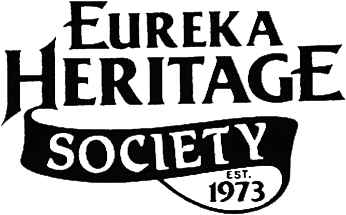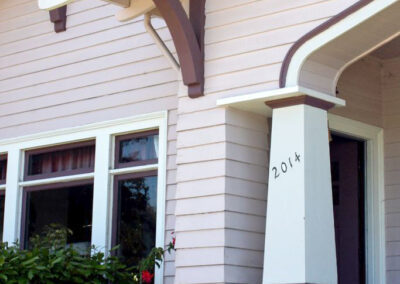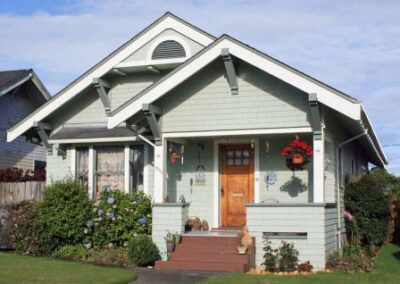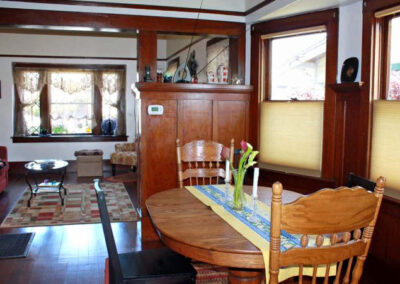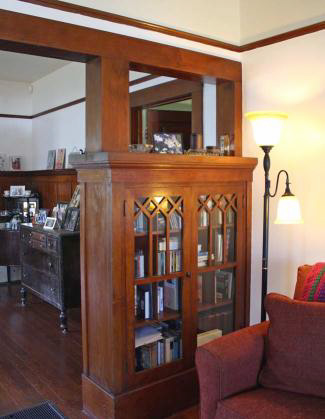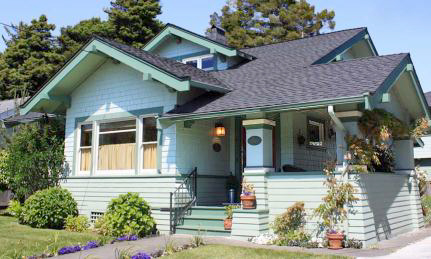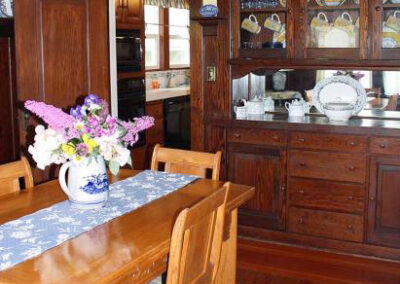
Saluting Eureka’s Craftsman Concepts
1905-1925
Article and photos by Kathy Dillon
The Victorian age was over. The ornate houses it produced, while still mainstream, were becoming symbols of a bygone era.
Enter the Craftsman bungalow—a quintessential early 20th-century American house style that blended artistry with intentional simplicity. Like many Americans, Eurekans fell in love with them. And while this love faded in the 1930s, it has been rekindled with fervor over the past 30-plus years.
Eureka’s first bungalows appeared around 1905. By late 1910, the Humboldt Times reported “practically every new residence which has been constructed this year is of the bungalow type. And, according to the plans of the homebuilders, the bungalow construction record for 1911 will exceed all other records in the history of homebuilding in Eureka.”
This story was being repeated in “every North American city and village that had an economic boom in the early 20th century,” according to history professor Robert Winter in his book “The California Bungalow.”
“It was the idea that simplicity and artistry could be in harmony that was central to the bungalow’s popularity,” he states.
It was also an affordable artistry, which, Winter adds, underscored “a more profoundly realized concept–respectability. The bungalow filled more than the need for shelter… It provided psychic fulfillment of the American Dream.”
Craftsman Battered Piers
Square piers and other structural elements may be tapered so that they are wider at the bottom than at the top. They can be composed of, or covered by, clapboard, shingles, river rock, bricks or stucco. There are many creative variations.
Craftsman Braces
These elements found under a low, broad roofline are exposed for the first time, imparting a natural, handcrafted appeal. They can be structural or simply decorative. Some rooflines also gently curve at the end and may have a flared peak.
Craftsman Windows
Patterns of smaller panes are placed on the top portions, with a single pane of glass below, often copying the one-third/two-thirds pattern seen on doors. Diamond-shaped panes or “lights” are another pleasing variation.
The B Street Cluster
For such an all-American house, the Craftsman bungalow has a remarkable global lineage. Its main roots go back to the English Arts and Crafts movement of the 1880s. The antithesis of the Industrial Revolution and Victorian flamboyance, it celebrated handcrafted workmanship and the use of simple forms and natural materials.
The term “Craftsman” was coined by Gustav Stickley, the famed Arts and Crafts furniture designer in the United States who published popular magazines on the subject from 1901 to 1916.
“Bungalow” comes from the province of Bengal in India, where single-family homes with broad porches are called “bangalas.” British colonists adapted the idea to their own summer houses.
Generally speaking, the term “Craftsman” applies to grander versions of the style, while the word “bungalow” describes the smaller working- and middle-class types.
America’s first Craftsman was a grand one built on the East Coast in the late 1800s. Yet it wasn’t until the early 20th century that its wide-scale popularity blossomed forth from Southern California.
Two Pasadena architects, Charles Sumner Greene and Henry Mather Greene, popularized the concept through myriad pattern books and magazines. They also added touches from Japan (curved eaves) and Switzerland (plentiful stylized woodwork).
Americans of all social levels were entranced. Eureka was no exception.
That 1910 Humboldt Times article cited the new Craftsman home of wealthy lumberman W.H. Hamilton on J Street as “one of the largest residences ever erected in Eureka.” The majority, however, were modest. In 1917, the Times again reported on the continued popularity of bungalows—with most moderately priced between $1,500 and $3,000.
“Young married couples,” Winter writes, “found that even if they were not well off, they could still afford a respectable home.”
They included couples like John and Selma Swensen. They had met in Sequoia Park, married in July 1915, and soon moved into their brand-new bungalow at 2142 B St.
Both were from Norway. At 17, John had left his bleak home north of the Arctic Circle on a schooner. Escaping a surly captain, he jumped ship in Mexico and by 1912 was working within Humboldt County’s logging industry.
Selma, from southern Norway, arrived in America in 1905. She spent her first night in a cockroach-invested sleeping area on Ellis Island–wide awake and curled upright against a wall. She, too, headed to the North Coast, where an uncle owned a mill and she found work as a domestic servant.
In their new house, the Swensens did not have far to look for friends. A dozen of the 16 bungalows along the 2100-2200 section of B Street were occupied by immigrants from their homeland. It was a scenario that continued for decades.
“The block was loaded with Scandinavians. They clustered together so they could hear their own language,” recalls the Swensens’ daughter Doris Gildesgaard, who finally sold the family home in 2003.
Among the Swensens’ earliest neighbors were Emil Sarin, another Norwegian, his California-born wife, Annie, and their small son. Their two-bedroom house at 2239 B St. is quite similar to the Swensen home. Current owner Mary Romaidis, who bought it in 2006, was sold at first sight.
“I was just looking for a one-story house, but when I saw the “I was just looking for a one-story house, but when I saw the Craftsmans, I loved them,” she says.
Mary knew ill-fitting modern touches in the kitchen would need to be redone and she would want to remove carpeting to reveal fine fir floors. What sold her was the rich amount of natural, old-growth redwood in the living room, dining room and foyer. Indeed, it is a typically exquisite small bungalow.
Janet and Evan Kopald own a larger one-story 1920s bungalow a block away at 2103 B St. For them, its Craftsman details were the icing on the cake of a largely well-cared-for house. Since moving in five years ago, they have chosen to redo the kitchen, uncover fir flooring and add a small building in back; all of it complements original bungalow elements.
Both these houses have classic Craftsman detailing under their broad low-pitched eaves: exposed rafters, beams and braces. Covered in Victorian times, these structural details were purposely exposed to show the fine workmanship. Sometimes they are decorative additions rather than functional elements.
Inside both houses, brick fireplaces and a plethora of wainscoting lend a homey welcome. Winter calls these types of houses “a comfortable abode in style for the average person. In that sense, they are revolutionary in the history of architecture.”
In a bungalow, virtually everything had to go on one floor—with flair. So, it was important to make small spaces look roomier. The solution: built-ins. The Romaidis house seems spacious thanks to a built-in dining room sideboard, bookcases that partially divide dining and living rooms and a built-in foyer bench.
Craftsman kitchens were also smaller yet more efficient. Labor-saving devices included built-in bread boards, flour and sugar bins, and ironing boards. It was all a dream come true.
The L Street Row
Eureka was thriving during the bungalow years, as its growing population proved. In 1900, the city had 7,300 people; by 1915 that number had grown to 15,000.
Improved transportation made all the difference to this isolated area once accessible only by sea. In 1914, the Northwest Pacific Railroad finally provided a land link between the North Coast and the urban south. In 1920, the Redwood Highway was completed. All the while, industry and businesses flourished.
New homes were steadily constructed throughout this era. Bungalows sprang up virtually everywhere—cozied in-between Victorians and clustered together in newer additions of the city. One row of 1½-story bungalows along the 2600-2700 blocks of L Street make an especially impressive scene.
Among them is the Winzler home at 2621 L St., a one-of-a-kind Craftsman that reflects the story of a notable American couple. It was built in 1919 for S. Herbert and Edith Anderson, and they sold it in 1924 to newlyweds George and Ruby Winzler.
The Winzlers met while attending Eureka Junior College, and both went on to earn degrees from U.C. Berkeley—George’s in engineering and Ruby’s in chemistry with a teaching credential.
By the early 1930s, the Winzlers had four children and made plans to extend the little house. George’s father, James, was a carpenter who had taught his son the trade. Together they enlarged the house outward and upward, care-fully maintaining exterior Craftsman details.
It was an ideal environment to grow up in, reflects youngest daughter Lura Winzler.
“Behind us there were only a couple of houses and then the redwoods,” she remembers. “All the neighborhood kids had a place back there we made as our den.”
During World War II, Ruby became an advocate of childcare for working mothers. It was an effort she continued for two decades, which is why the Winzler Children’s Center was built and named in her honor. George’s success included the founding of the Winzler & Winzler Consulting Engineering Firm in 1952, which still exists today as Winzler & Kelly.
George died in 1964, Ruby in 1988. Family still lives in the Winzler house, where the clan gathers every year for a reunion.
When Ruby Winzler was a teen on her family’s farm, she would scurry down the hill on school morn-ings to catch the train into Fortuna. Luckily, engineer Walter Cave always waited for her.
A decade later they became neighbors when Ruby and her new husband moved next door to the Cave family.
Walter and Grace Cave raised their four children at 2615 L St., and they lived out their days there. The house was finally sold in the 1960s and had several owners before Sandra and Mark Greenleaf bought it in 2001.
“We walked in the door and said: ‘That’s it.’” recalls Sandra, who is an interior designer. “We had always wanted a Craftsman…and one where the woodwork wasn’t painted over.”
In foggy Humboldt County, original darker wood often gets painted brighter colors, but Craftsman woodwork, she explains, was intended to have a natural appearance. Another plus is the use of space: While Victorians tend to have smaller rooms with high ceilings, Craftsmans have a horizontal emphasis with more spacious, open floor plans.
Since moving in, the Greenleafs have painted, stenciled walls, polished woodwork, added period light fixtures and blended antique accents with comfy overstuffed chairs and couches. It all underscores their sentiments toward the Craftsman concept.
“My grandparents had a house like this,” Sandra says. “I guess that’s why I like it. They’re just so welcoming and homey.”
